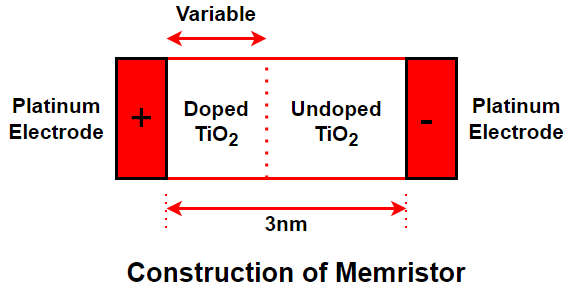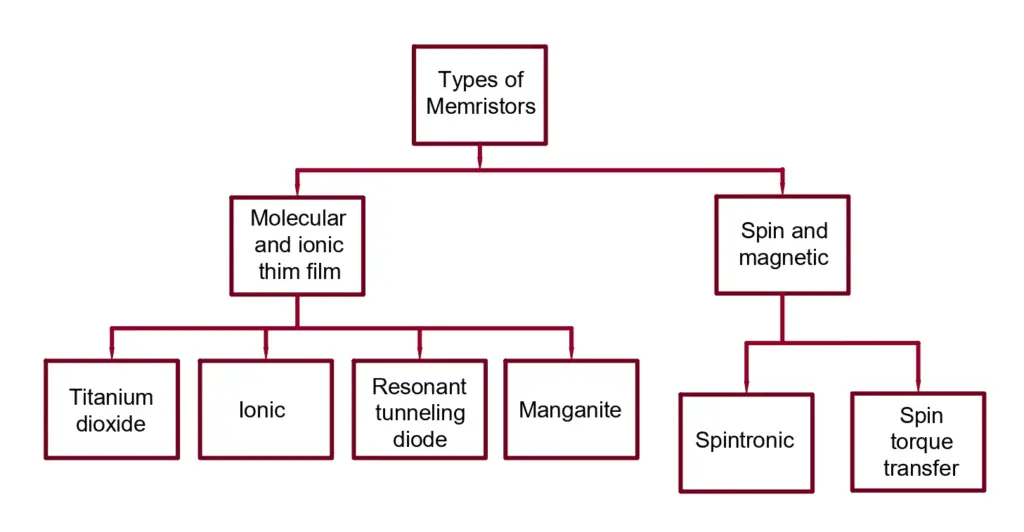Definition: A Memristor, a memory resistor, is a passive two-terminal solid-state nonlinear electrical component that can “remember” the amount of charge that has flowed through it. Besides resistors, capacitors, and inductors, the memristor is a fourth fundamental element in an electrical circuit.
Memristor is an English word that is made by merging two words or formed from the two words memory and resistor. It is similar to a resistor but with memory.
Every electrical engineer is familiar with the capacitor, resistor, and inductor, the three basic passive elements. They are called fundamental elements because they cannot be built with a combination of any other. They are independent and passive because they do not need an external power supply to function.

The memristor can “remember” the electronic state and represent it using analog signals. A circuit of this type makes it possible to produce computers with instantaneous ignition, without it being necessary to reload the operating system at each start. The circuit retains information even without an electric current when the computer is turned off.
The possibility of storing analog signals makes it possible to store and process a quantity of data much larger than that processed by digital circuits, capable of representing only two states (0 and 1). The memristor is a new generation of memory and computing power.
Symbol of Memristor

Working Principle of Memristor
The working principle of a memristor is based on the relationship between the charge q (electric charge) and the flux φ (magnetic flux) linking the two terminals of the device. This relationship can be expressed by the equation:

where Φ is the magnetic flux, and M is a function that describes the relationship between charge(q) and flux(Φ). This function is nonlinear and depends on the material properties of the memristor.
When a voltage is applied across the terminals of the memristor, a current flows through it, causing a change in the device’s internal structure. This change in structure alters the relationship between charge and flux, effectively changing the memristor’s resistance. The resistance of the memory resistor depends on the amount of charge that has flowed through it in the past, making it a non-volatile memory device.
Thus, the memristor regulates the value of the electrical flow corresponding to a datum according to the history of voltages applied to it. Data can be stored and processed simultaneously, making the memristor much more efficient than legacy systems.
Dynamic electronic devices are passive components that manage data storage like a variable resistor. Like a resistor, it executes and maintains a safe current flow through a device, remembering the last charge it passed.
A memristor differs from an ordinary resistor. It can “remember” charges even when no current or voltage is present. Therefore, the information can still be stored even when the device is turned off.
Construction of Memristor
The memristor is a two-terminal device. Its resistance depends on the voltage polarity, duration, and magnitude.

A memristor is typically constructed using thin films of metal oxides, such as titanium dioxide (TiO2), sandwiched between two electrodes. The metal oxide layer is the active component of the memristor where the resistance change occurs. The internal section of the titanium dioxide is divided into two parts. One part of the element is doped with titanium dioxide, and the second is left undoped.
When we apply a voltage across the electrodes, the oxygen atom present in titanium dioxide starts diffusing. The direction of oxygen atom diffusion depends on the polarity of the applied voltage. The diffusion of the oxygen atom causes a change in the resistance of the doped portion of titanium oxide.
History of Memristor
Dr. Leon Chua, a professor at California University, introduced the memory resistor theory foremost in 1971. He described it as an electrical passive element, which he named memristor.

Professor Chua noticed a missing relationship in circuit theory, which led to the prediction of the existence of a fourth passive fundamental element.
Although memory resistors always follow the fundamental circuit and variables of voltage, current, and time integrals, they have a dynamic function with memory. They can be described as a net load function. The same is not found in the three other fundamental circuit elements (resistor, inductor, and capacitor).

The memristor is also capable of logical functions. This can significantly change the current compartmentalized structure of computing, as it allows the creation of devices capable of processing and storing data in the same space. Currently, there is no standard memory resistor, but each device implements a particular function. In such a case, the voltage integral determines the current integral, and vice versa.
Characteristics of Memristor
Voltage & Current (V-I) Characteristics

An important demonstration of the memristor is its characteristic V-i hysteresis curve excited by a periodic signal such as square, sinusoidal, etc.
For a Memristor turned on by a periodic signal (square or sinusoidal), it can be seen from the above figure that when the voltage is zero, the current is also zero, and vice versa. So, the voltage and the (v, i) current comply with identical zero crossing.
Magnetic flux and charge (Φ-q) Characteristics

A Memristor is a two-terminal passive circuit element with a non-linear relationship between electrical charge (q) and magnetic flux (Φ) connection. It can be seen from the above figure that the charge slowly becomes zero as the magnetic flux y-axis.
Types of Memristor
Memristors are classified into several types based on their design, and an overview of these types is given below. We can classify them into two broad categories. They are-
- Molecular and Ionic Thin-film
- Spin and Magnetic

Now, we will discuss the sub-categories of the memristor.
Molecular and Ionic Thin-film Memristors
Molecular and ionic thin-film memristors depend on the different properties of the materials and the initiation of hysteresis in the material after incorporating charge.
Titanium dioxide
This type of memristor has titanium dioxide as the main element. Its hysteresis occurs due to oxygen transfer between the layers after it is charged.
Ionic
The ions are of two types: anions and cations. The ion can move a charge from one place to another in any direction when the ion is in a solid state, The hysteresis in the material can be developed by dynamic doping. It has a single passive layer between the electrode and the polymer as an active material. The polymer forces the ions. and as a result, it moves from the electrode to the film. It functions on the principle of the ‘Electrolytic process”.
Manganite
Manganite is similar in construction and functionality to titanium dioxide. In Manganite, manganite oxide film is used instead of titanium oxide.
Resonant-Tunneling diode
It utilizes the multiple-quantum-well diodes, and therefore it can utilize dynamic doping and generate hysteresis among the film layers.
Magnetic Effect and Spin Technology
The development of this type of memristor is based on the degree of freedom technology. The polarization of the spinning electrons can be controlled by the magnetic field created by the moving magnet, and thus, hysteresis is generated.
Spintronic
Spintronic technology is similar to titanium dioxide memristors. In this, we can change the direction of the spinning electron by using a movable magnet. As a result, hysteresis is generated between the devices.
Spin Torque Transfer
MRAM (magnetoresistive random access memory) is a memristive component by nature. The hysteresis is generated by MRAM’s Spin Valve Technology. The spin valve technology varies the resistance, and as a result, the current is induced through the junction made up of magnets. The MRAM inherently has magnetic and ionic characteristics.
Three-terminal Memristors
In 1960, Bernard Widrow designed a memristor with three terminals using Electroplating technology. The ‘non-solid states’ generate the hysteresis. The time integration of the current controls the system’s conductance.
Advantages
Memristors have many advantages. They are-
- It uses power when the device is active, similar to ‘non-volatile memory. Therefore, it requires less energy to operate.
- It produces less heat.
- They are faster than current technologies, such as SSD memories.
- They are less expensive.
- They can store twice as much data on the same surface.
- Memristors are insensitive to radiation like transistors.
- Because they provide nonvolatile memory, they can prevent computers from needing to be rebooted. The user would find his files and applications in the state where he had left them, allowing us to reboot a PC as quickly as we turn on a light bulb.
Disadvantages
- Since these devices are still in development, their future depends on determining the best hardware implementation.
- The speed and the performance of memristors are not at par with the speed of DRAM and transistors.
- They are not commercially available.
Applications
Potential areas of application of Memristors are-
- It can be used as a switch, connecting the multiple inputs and outputs in the matrix. It is also called a ‘Matrix Switch’.
- In the PLC device, signal processing
- In the super-resolution imaging
- Physical neural networking
- In the Control systems
- In Digital Circuits
- Biological and neuromorphic systems.
- Computer and networking technology